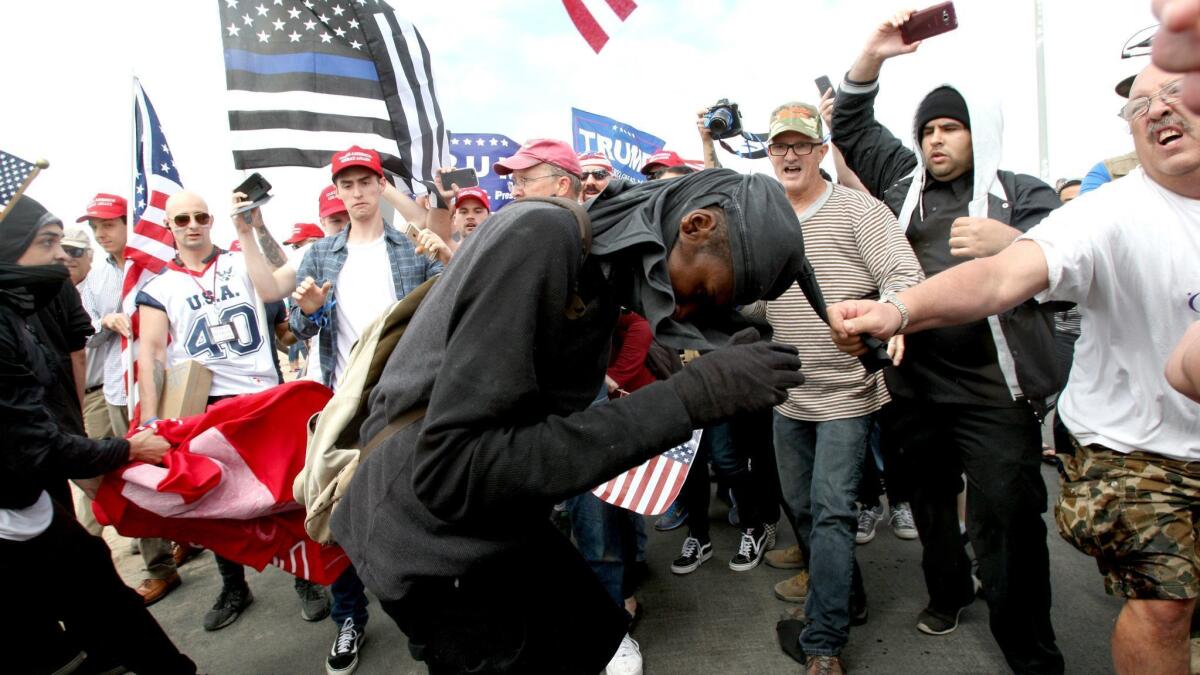Arrests of white power leaders are a reminder of Huntington Beach’s painful past
- Share via
Last week’s arrests of four members of a Huntington Beach-based white supremacist group raised questions about whether Surf City has indeed overcome the racist episodes of its past, as city leaders suggest, or continues, as critics contend, to incubate extremism.
Officials pointed to the low number of arrests for hate crimes and argued that the county’s fourth-largest city is increasingly diverse and welcoming.
But Latinos living in historically blue collar areas and civil rights watchdogs said racism persists — not so obviously on Main Street like it once did but in online forums and at provocative beachfront protests.
“How does a community shake a myth?” posited Mayor Mike Posey, adding that suggestions that Huntington Beach is some kind of “epicenter” for white supremacists are “laughable.”
“Huntington Beach is (a) blended, diverse culture where everyone is welcome.”
Not so fast, argued Los Angeles Times columnist Gustavo Arellano, who covered hate groups extensively while editing OC Weekly.
“If Huntington Beach proclaimed war against neo-Nazis, I sure as hell never heard of it,” Arellano said.
New arrests pick at old wounds
Memories of old racial tensions resurfaced last week when the FBI arrested Huntington Beach resident Robert Rundo on suspicion of conspiring to violate the federal riots statute. Rundo is a key member of the Rise Above Movement, an alt-right street-fighting gang.

In March 2017, RAM participated at a Make America Great Again rally at Bolsa Chica State Beach, where members attacked counter-protesters and two journalists, according to the FBI.
The federal criminal complaint charges the four RAM members of traveling to political rallies across California to engage in a series of violent attacks and conspiring to violate riot statutes.
The affidavit alleges that the men used the internet to organize their activities, coordinate “combat training” and “celebrate their acts of violence in order to recruit members for future events.”
Although Huntington Beach has a history of racially-charged incidents involving skinheads and others, city officials argued that H.B. has moved forward, even if outsiders don’t know it.
“We unfairly get labeled with that every time something comes up again,” said Police Chief Robert Handy, who has said that he’s made diversity a priority in his department.
The ’80s and ’90s were different
In the mid-1980s, Huntington Beach gained a reputation for drawing both local and out-of-town white supremacists. The pier and downtown area became gathering spots for young people with shaved heads, swastika tattoos and steel-toed boots.
In 1994, 19-year-old Jonathan Russell Kennedy fatally shot 44-year-old African American Vernon Windell Flournoy outside a McDonald’s restaurant. A week after his arrest, Kennedy was charged with the attempted murder of two Latino men in a shooting that occurred just weeks prior. The gunman pleaded guilty to both the murder and attempted murder charges with hate crime enhancements. A 17-year-old was also charged with Flournoy’s murder and tried as an adult.
In 1996, Erik R. Anderson, 22, of Huntington Beach stabbed a 20-year-old Native American, George Mondragon, 27 times at the beach. Anderson was convicted of attempted murder and given a life sentence.
These two hate crimes prompted city officials to take action. The city created the Human Relations Task Force to promote and celebrate cultural diversity through tolerance and education. Police report hate speech and other issues to the group.
Handy credits these and other efforts with improving relationships.
Rundo’s arrest, Handy said, “isn’t reflective of our community,” which has come “an awful long way.”
He said his officers log about two hate crimes a year.
However, one expert argued that racist groups still persist.
“We have a problem with denying the problem of hate groups in our country,” Chapman University sociology professor Peter Simi said. “That’s our default mode.”
Though Huntington has improved, Simi said there is a “substantial problem” across Orange County and Southern California.
Simi explained people wouldn’t recognize neo-Nazis or white supremacists walking down Main Street; they now look like everyone else.
“If you examine Huntington Beach in social media, my sense [is] it would be more than you might expect,” he said.
Arellano cited a hate crime incident in the last decade where four white supremacists entered a home in the Hispanic Oak View neighborhood and tried to murder a Latino man.
Oscar Rodriguez, who lives in the neighborhood, doesn’t hear racist remarks yelled on the streets, but agreed they are “being said over the internet.”
He called on politicians to do something about it.
“If public officials aren’t outright denouncing hate incidents, then the culture is going to stick around,” he said. “If this isn’t a priority to them, it’s going to keep going on.”
SB 54 challenge angered many Latinos
Rodriguez also expressed concern with the City Council’s court-upheld decision to ignore the state’s “sanctuary city” law protecting immigrants.
Senate Bill 54 in many cases prohibits state and local police agencies from notifying federal officials about the impending release of immigrants in custody who may be deported. Huntington Beach rejected enforcement of the bill, using its city charter to beat a state challenge in court.
Rodriguez called the action “an excuse to get away with using the city charter.”
But City Attorney Michael Gates doesn’t see it that way.
“We will continue to hold Sacramento accountable for unconstitutional state law overreaches,” he told the Daily Pilot last month.
California has the nation’s largest racist skinhead population, according to the Anti-Defamation League, an organization tracking anti-Semitic incidents since 1979.
RAM, the organization affiliated with Rundo, is estimated to have 50 members, several of whom have violent criminal histories. Rundo previously served prison time for a gang-related felony in New York, according to court records.
And Matthew Branstetter of Huntington Beach, also an ex-con, has been known to train with RAM,, according to the nonprofit investigative news agency ProPublica.
Branstetter is a known member of Hammerskin Nation, which the ADL classifies on its website as “the most violent and best-organized neo-Nazi skinhead group in the United States.”
In 2011, Branstetter was convicted of aggravated assault with a hate crime enhancement and sentenced to three years in state prison after beating a 23-year-old Jewish man in Coto de Caza, court records show.
Joanna Mendelson, a senior ADL researcher, said groups like RAM romanticize themselves as soldiers on the front line, helping defend a “‘victimized white population.’”
Statistics reflecting hate crimes in Huntington Beach were not immediately available, but the number of hate crimes rose in Orange County for the third year in a row, according to an annual report by the Orange County Human Relations Commission.
Anti-Semitic incidents went up 60% nationwide and 27% in California, according to the ADL.
“There are bad actors that may have ties to Huntington Beach, but it is no different than other cities in Southern California,” Mendelson said. “We have to change the stereotype.”
One elected official said that the city is far better than it once was but agreed there’s still work to do.
“Once you get a bad reputation, it’s a long road to improving that reputation,” said Councilwoman Jill Hardy, who teaches at Marina High School. “I’m optimistic we’ve worked on it. It doesn’t mean we can’t do more to improve the situation and our reputation, but I have seen some positive movements when I’m with high school students.”
Twitter: @vegapriscella
All the latest on Orange County from Orange County.
Get our free TimesOC newsletter.
You may occasionally receive promotional content from the Daily Pilot.





